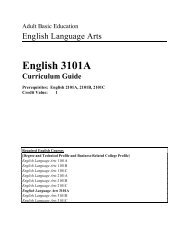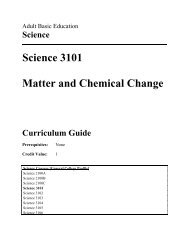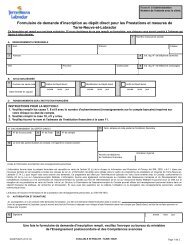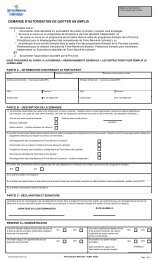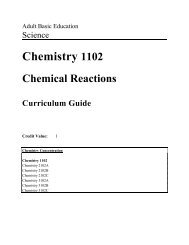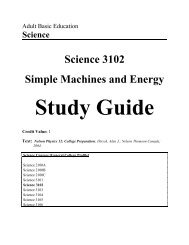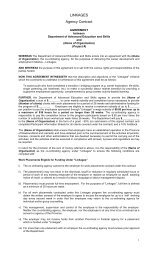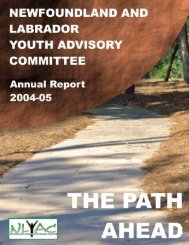Biology 2101A The Cell - Department of Advanced Education and ...
Biology 2101A The Cell - Department of Advanced Education and ...
Biology 2101A The Cell - Department of Advanced Education and ...
You also want an ePaper? Increase the reach of your titles
YUMPU automatically turns print PDFs into web optimized ePapers that Google loves.
Table <strong>of</strong> ContentsTo the Instructor...............................................................vIntroduction to <strong>Biology</strong> <strong>2101A</strong> .............................................vCurriculum Guides.......................................................vStudy Guides .......................................................... viResources ............................................................. viRecommended Evaluation ............................................... viiUnit 1 - <strong>The</strong> Micro-universe <strong>of</strong> the <strong>Cell</strong> ....................................... Page 2Unit 2 - Interaction <strong>of</strong> <strong>Cell</strong> Structures ......................................... Page 8Unit 3 - Photosynthesis <strong>and</strong> Respiration ...................................... Page 10Appendix A ............................................................ Page 13
To the InstructorI. Introduction to <strong>Biology</strong> <strong>2101A</strong><strong>Biology</strong> <strong>2101A</strong> is a pre-requisite for all remaining <strong>Biology</strong> courses in the <strong>Biology</strong>concentration. It covers the proper use <strong>of</strong> the microscope. It also includes a detailed study<strong>of</strong> the structure <strong>and</strong> functioning <strong>of</strong> both plant <strong>and</strong> animal cells. Finally, it introduces two<strong>of</strong> the important chemical processes , photosynthesis <strong>and</strong> respiration, that occur in cells.<strong>Biology</strong> <strong>2101A</strong> is the first <strong>of</strong> 3 courses (the others are <strong>Biology</strong> 2101B <strong>and</strong> <strong>Biology</strong>2101C) that are equivalent to <strong>Biology</strong> 2201 in the current high school program.II.Curriculum GuidesEach new ABE Science course has a Curriculum Guide for the instructor <strong>and</strong> a StudyGuide for the student. <strong>The</strong> Curriculum Guide includes the specific curriculum outcomesfor the course. Suggestions for teaching, learning, <strong>and</strong> assessment are provided to supportstudent achievement <strong>of</strong> the outcomes. Each course is divided into units. Each unitcomprises a two-page layout <strong>of</strong> four columns as illustrated in the figure below. In somecases the four-column spread continues to the next two-page layout.Curriculum Guide Organization:<strong>The</strong> Two-Page, Four-Column SpreadUnit Number - Unit TitleUnit Number - Unit TitleOutcomesSpecificcurriculumoutcomes forthe unit.Notes for Teaching <strong>and</strong>LearningSuggested activities,elaboration <strong>of</strong> outcomes, <strong>and</strong>background information.Suggestions for AssessmentSuggestions for assessingstudents’ achievement <strong>of</strong>outcomes.ResourcesAuthorized <strong>and</strong>recommendedresources thataddressoutcomes.Curriculum Guidev<strong>Biology</strong> <strong>2101A</strong>
To the InstructorV. Recommended EvaluationWritten Notes 10%Labs/Assignments 20%Test(s) 20%Final Exam (entire course) 50%100%<strong>The</strong> overall pass mark for the course is 50%.Curriculum Guidevii<strong>Biology</strong> <strong>2101A</strong>
<strong>The</strong> <strong>Cell</strong>
Unit 1 - <strong>The</strong> Micro-universe <strong>of</strong> the <strong>Cell</strong>Outcomes1.1 Explain the cell theory.1.1.1 State the fourhypotheses <strong>of</strong> the celltheory.1.1.2 Define biogenesis<strong>and</strong> abiogenesis.1.2 Select <strong>and</strong> use apparatus <strong>and</strong>materials safely.1.2.1 Identify themicroscope as an importanttool for biological research.1.3 Use instruments effectively<strong>and</strong> accurately for collecting data.1.3.1 Identify microscopeparts <strong>and</strong> their function.1.3.2 Demonstrate generalcare, focusing techniques<strong>and</strong> safety concerns.1.3.3 Prepare, stain, <strong>and</strong>observe a wet mount <strong>of</strong> aspecimen.Notes for Teaching <strong>and</strong> LearningStudents will be introduced to many new termsthroughout this course. Instructors could suggest thatstudents start a vocabulary list <strong>and</strong> add to it regularly asthey work through the unit.Students will go to the lab for the first time in this courseto fulfill the requirements for this section. Instructorsshould review “Safety in the Lab”, (Appendix A <strong>of</strong> thetext), with students before they start to work in the lab.Students should develop the techniques <strong>and</strong> skills requiredfor a microscope’s efficient use. Students will arrive in<strong>Biology</strong> <strong>2101A</strong> with varying levels <strong>of</strong> competency in theuse <strong>of</strong> the microscope <strong>and</strong> accommodations will need tobe made for this.If both a compound microscope <strong>and</strong> dissecting (stereo)microscope are available, a look at the contrasts <strong>and</strong>different uses for these two instruments would bevaluable.Instructors should demonstrate the proper preparation <strong>and</strong>staining <strong>of</strong> a temporary, or wet mount slide, in order tominimize air bubbles <strong>and</strong> distractions to viewing.Students could be provided with blank copies <strong>of</strong> amicroscope diagram to use for practice.Curriculum GuidePage 2<strong>Biology</strong> <strong>2101A</strong>
Unit 1 - <strong>The</strong> Micro-universe <strong>of</strong> the <strong>Cell</strong>Suggestions for AssessmentQuestions 1.1 - 1.2 in the Study Guide should be assigned tocover Outcome 1.1. Students will find the answers to thesequestions in Section 1.1.Question 1.4 in the Study Guide <strong>and</strong> the Core Lab should beassigned to cover Outcomes 1.2 <strong>and</strong> 1.3. Students will find theanswers to these questions in Section 1.2 (including Investigation1.A).Instructors should assess the student’s level <strong>of</strong> underst<strong>and</strong>ing byreading student answers to questions from the Study Guide <strong>and</strong>providing feedback.Instructors should ensure that all necessary terms are being addedto the student’s vocabulary list <strong>and</strong> provide students with ideasabout how to successfully remember definitions.ResourcesMcGraw-Hill Ryerson<strong>Biology</strong>, pages 6, 12 - 22.McGraw-Hill Ryerson<strong>Biology</strong>, Teacher’sResource.McGraw-Hill Ryerson<strong>Biology</strong>, Teacher’sResource CD-ROM.Core Lab: Investigation1.A, “Caring for <strong>and</strong> Usinga Microscope”, pages 15 -19.www.gov.nl.ca/edu/science_ref/main.htmhttp://www.mcgrawhill.ca/school/booksites/biology/Curriculum GuidePage 3<strong>Biology</strong> <strong>2101A</strong>
Unit 1 - <strong>The</strong> Micro-universe <strong>of</strong> the <strong>Cell</strong>Outcomes1.4 Compile <strong>and</strong> display, usingline diagrams <strong>and</strong>/or digitalimagery, evidence <strong>and</strong> informationcollected through the use <strong>of</strong> themicroscope.1.4.1 Draw a biologicaldrawing which includes theconcept <strong>of</strong> field <strong>of</strong> view <strong>and</strong>calculation <strong>of</strong> specimensize.1.4.2 Define depth <strong>of</strong> field.1.4.3 Define resolution.1.5 Using different types <strong>of</strong> cellsas examples, compare <strong>and</strong> contrastprokaryotic <strong>and</strong> eukaryotic cells.1.5.1 Describe thestructural differencesbetween prokaryotic <strong>and</strong>eukaryotic cells.Notes for Teaching <strong>and</strong> LearningOutcome 1.4 is covered by doing Investigation 1.A.Instructors should review “How to Make BiologicalDrawings” (found in Appendix E <strong>of</strong> the text), withstudents before they complete Part D <strong>of</strong> the lab.Instructors should refer to the Teacher’s Resource forinformation to help with Investigation 1.A.<strong>The</strong> Teacher’s Resource also provides answers to all thequestions in the text.<strong>The</strong> Mini Lab, “Observing Stained <strong>Cell</strong>s”, page 24, maybe used as practice for preparing <strong>and</strong> observing stainedslides.<strong>The</strong> Teacher’s Resource CD-ROM contains BlacklineMasters (BLM’s), Labs, Additional Investigations <strong>and</strong>Assessment Checklists.<strong>The</strong> figures throughout Section 1.3 <strong>of</strong> the text (<strong>and</strong>diagrams from other sources) may be used to achieveoutcome 1.5.2.1.5.2 Observe features <strong>of</strong>prokaryotic <strong>and</strong> eukaryoticcells using microscopetechnology <strong>and</strong>/or diagrams.Curriculum GuidePage 4<strong>Biology</strong> <strong>2101A</strong>
Unit 1 - <strong>The</strong> Micro-universe <strong>of</strong> the <strong>Cell</strong>Suggestions for AssessmentBLM 1-1, “Using a Microscope”, can be copied <strong>and</strong> distributed tostudents for review <strong>and</strong> reinforcement.ResourcesBLM 1-1, “Using aMicroscope”.A Microscope Diagram should be provided to students <strong>and</strong>completed <strong>and</strong> passed in with their lab report. Students should beprepared to complete a similar diagram for the exam on thiscourse. Instructors may use various resources to choose anappropriate diagram.Instructors should assess the student’s lab report. A mark shouldbe assigned for lab work <strong>and</strong> used as part <strong>of</strong> the evaluation for thecourse.Curriculum GuidePage 5<strong>Biology</strong> <strong>2101A</strong>
Unit 1 - <strong>The</strong> Micro-universe <strong>of</strong> the <strong>Cell</strong>Outcomes1.6 Describe the appearance <strong>and</strong>function <strong>of</strong> cell organelles.1.6.1 Define organelle.1.6.2 Describe the role <strong>of</strong>the following cellularstructures:(i) cell membrane(ii) cytoplasm(iii) nucleus(iv) nucleolus(v) endoplasmic reticulum(vi) ribosome(vii) mitochondria(viii) chloroplast(ix) vacuole(x) vesicle(xi) golgi apparatus(xii) microtubules /filaments(xiii) cilia(xiv) lysosome(xv) flagella(xvi) cell wallNotes for Teaching <strong>and</strong> LearningMany students have difficulty with spellings <strong>and</strong>pronunciations <strong>of</strong> cell organelles. If available, anaudiotape or videotape could be very useful to help withthat. Encourage students to break each word into syllablesto help them learn.Physical models, charts <strong>of</strong> cells, <strong>and</strong>/or Internet websitesgraphically illustrate structures <strong>of</strong> cells <strong>and</strong> distinguishfeatures predominant in plant or animal cells.Comparison <strong>of</strong> diagrams on pages 25 <strong>and</strong> 32 <strong>of</strong> textbookcan aid in highlighting these differences.Instructors should provide students with unlabelleddiagrams <strong>of</strong> plant <strong>and</strong> animal cells to use for practice inrecognizing organelles.1.6.3 Compare plant <strong>and</strong>animal cells in terms <strong>of</strong> type<strong>of</strong> organelles presentCurriculum GuidePage 6<strong>Biology</strong> <strong>2101A</strong>
Unit 1 - <strong>The</strong> Micro-universe <strong>of</strong> the <strong>Cell</strong>Suggestions for AssessmentInstructors should check the diagrams that have been provided tostudents to ensure they are being labelled properly.Questions 1.5 - 1.9 in the Study Guide should be assigned tocover Outcomes 1.5 <strong>and</strong> 1.6. Students will find the answers tothese questions in Section 1.3.This is the end <strong>of</strong> Unit 1. Instructors may assign questions fromthe Section Reviews <strong>and</strong>/or the Chapter Review, <strong>and</strong> assessstudent answers.ResourcesAudio <strong>and</strong>/or video tapes <strong>of</strong>parts <strong>of</strong> the cell.<strong>Cell</strong> Diagrams from variousresources.<strong>Biology</strong> 11/12Computerized AssessmentBanks.Answers for all questions in the text are provided in the Teacher’sResource.Students should practice labelling cell diagrams until they areable to label them accurately without referring to the text.Instructors may also give a chapter quiz that may be used as part<strong>of</strong> the final mark for the course.Curriculum GuidePage 7<strong>Biology</strong> <strong>2101A</strong>
Unit 2 - Interaction <strong>of</strong> <strong>Cell</strong> StructuresOutcomes2.1 Explain how materials are ableto move into <strong>and</strong> out <strong>of</strong> cellsthrough a selectively permeablemembrane.2.1.1 Define homeostasis.2.1.2 Explain the termselectively permeable.2.1.3 Describe forms <strong>of</strong> passivetransport (includediffusion <strong>and</strong> osmosis).Notes for Teaching <strong>and</strong> LearningOutcome 2.2 is covered by doing Investigation 2.B. <strong>The</strong>lab is written so that students determine their ownexperimental plan. Instructors may substitute a similarlaboratory activity for this one to achieve the sameoutcome.Instructors should encourage students to add the newterms that they are learning in this unit to the vocabularylist that they started in Unit 1.2.1.4 Define the termshypotonic, hypertonic <strong>and</strong>isotonic.2.1.5 Distinguish betweenactive <strong>and</strong> passivetransport.2.1.6 Explain the processes <strong>of</strong>endocytosis ( includepinocytosis <strong>and</strong>phagocytosis) <strong>and</strong>exocytosis.2.2 Determine how thecomposition <strong>of</strong> extracellular fluidsaffects osmosis.Curriculum GuidePage 8<strong>Biology</strong> <strong>2101A</strong>
Unit 2 - Interaction <strong>of</strong> <strong>Cell</strong> StructuresSuggestions for AssessmentQuestions 2.1 - 2.5 in the Study Guide should be assigned tocover Outcome 2.1.1 - 2.1 5. Students will find the answers tothese questions in Section 2.2 <strong>of</strong> the text.Questions 2.7 - 2.8 in the Study Guide should be assigned tocover Outcome 2.1.6. Students will find the answers to thesequestions in Section 2.3 <strong>of</strong> the text.Instructors should assess the student’s ‘lab report’. A mark couldbe assigned for lab work <strong>and</strong> used as part <strong>of</strong> the evaluation for thecourse.ResourcesMcGraw-Hill Ryerson<strong>Biology</strong>, pages 38 - 67.BLM 2-2, “IllustratingConcentration Gradients”.Core Lab: Investigation2.B, “Osmosis in a Model<strong>Cell</strong>”, pages 56-57.BLM 2-2, “Illustrating Concentration Gradients”, may be used toassess the student’s underst<strong>and</strong>ing <strong>of</strong> the direction <strong>of</strong> osmosis.Curriculum GuidePage 9<strong>Biology</strong> <strong>2101A</strong>
Unit 3 - Photosynthesis <strong>and</strong> RespirationOutcomes3.1 Compare <strong>and</strong> contrast matter<strong>and</strong> energy transformationsassociated with the processes <strong>of</strong>photosynthesis <strong>and</strong> aerobicrespiration.3.1.1 Explain the importance <strong>of</strong>the processes <strong>of</strong>photosynthesis <strong>and</strong>aerobic respiration forindividual organisms.3.1.2 Demonstrate, usingequations, thatphotosynthesis <strong>and</strong>aerobic respiration arecomplementary processes.Notes for Teaching <strong>and</strong> Learning<strong>The</strong> emphasis <strong>of</strong> outcome 3.1 is the difference betweenaerobic processes <strong>and</strong> photosynthetic processes. It is notintended for students to investigate biochemical processes(such as Kreb Cycle, glycolysis, fermentation, <strong>and</strong> so on)or light <strong>and</strong> dark reactions associated with plant growth.Students should underst<strong>and</strong> that photosyntheticorganisms, using light as an energy source, remove CO 2,water <strong>and</strong> other materials from their environment in orderto assemble more complex organic compounds <strong>and</strong>release, as a by-product, oxygen gas. Students shouldunderst<strong>and</strong> that respiration is a chemical process utilizedby all organisms to extract energy from organicmolecules. <strong>The</strong>se organic substances are broken downinto their components <strong>of</strong> CO 2 <strong>and</strong> water. <strong>The</strong> energyreleased is utilized by the organism for its own purposesor released to the environment.Students who have recently completed <strong>Biology</strong> 1101 willbe familiar with the concepts covered in this unit. <strong>The</strong>yshould be reminded <strong>of</strong> what they have already learned.Instructors could assign selected questions from theSection Review, Chapter Review <strong>and</strong>/or Unit Review forreview <strong>and</strong> reinforcement. Instructor prepared reviewsheets could also be provided.Curriculum GuidePage 10<strong>Biology</strong> <strong>2101A</strong>
Unit 3 - Photosynthesis <strong>and</strong> RespirationSuggestions for AssessmentInstructors should assess the student’s level <strong>of</strong> underst<strong>and</strong>ing byreading student answers to questions from the Study Guide <strong>and</strong>providing feedback.Student answers for review questions should be assessed todetermine their readiness for a final exam.Instructors should give a final examination at the end <strong>of</strong> thecourse which covers all units <strong>of</strong> the course.ResourcesMcGraw-Hill Ryerson<strong>Biology</strong>, pages 68, 70, 73,82.<strong>Biology</strong> 11/12Computerized AssessmentBanks.Curriculum GuidePage 11<strong>Biology</strong> <strong>2101A</strong>
Appendix ADiagrams
11.Generalized Structure <strong>of</strong> a Plant <strong>Cell</strong>Curriculum GuidePage 15<strong>Biology</strong> <strong>2101A</strong>
Generalized Structure <strong>of</strong> an Animal <strong>Cell</strong>Curriculum GuidePage 16<strong>Biology</strong> <strong>2101A</strong>
Answer Sheets
central vacuoleribosomesendoplasmic reticulumnucleolus11.golgi bodynucleuscell wallcell membranemitochondrionnuclear envelopechloroplastsGeneralized Structure <strong>of</strong> a Plant <strong>Cell</strong> - ANSWER SHEETCurriculum GuidePage 19<strong>Biology</strong> <strong>2101A</strong>
smooth endoplasmicreticulumvacuolerough endoplasmicreticulummitochondrionribosomesnuclear poresnucleoluscell membraneribosomenucleuslysosomegolgi apparatuscentriolesnuclear envelopeGeneralized Structure <strong>of</strong> an Animal <strong>Cell</strong> - ANSWER SHEETCurriculum GuidePage 20<strong>Biology</strong> <strong>2101A</strong>
Curriculum GuidePage 21<strong>Biology</strong> <strong>2101A</strong>




